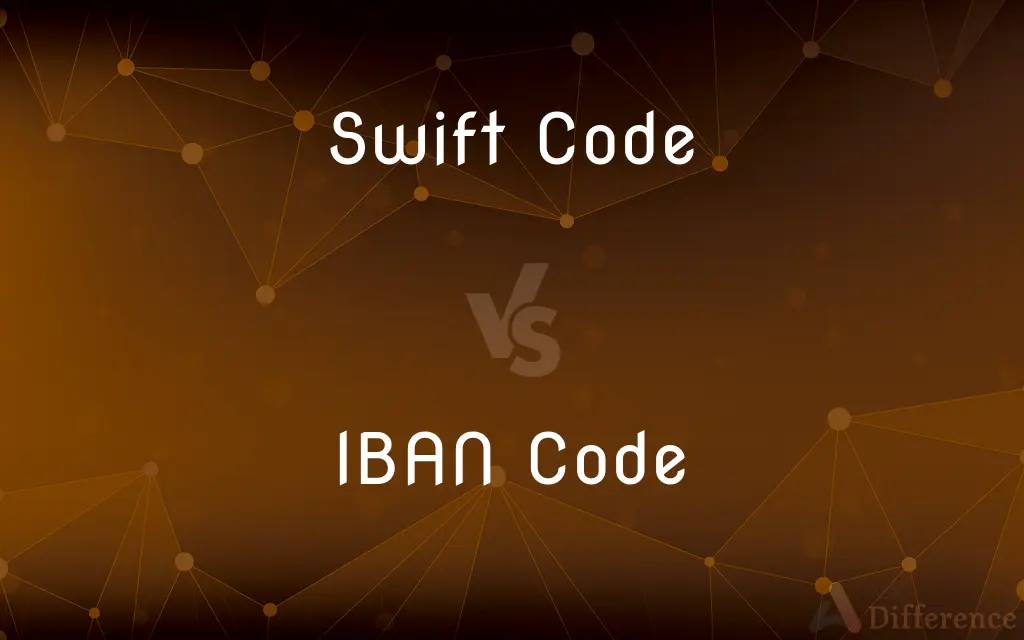Swift Code vs. IBAN Code — What's the Difference?
By Tayyaba Rehman & Maham Liaqat — Updated on April 24, 2024
A SWIFT code is used to identify a specific bank during international transactions, while an IBAN code identifies an individual account in international transfers.

Difference Between Swift Code and IBAN Code
Table of Contents
ADVERTISEMENT
Key Differences
The Society for Worldwide Interbank Financial Telecommunication (SWIFT) code is a standard format for Business Identifier Codes (BIC). It's used to identify banks and financial institutions globally, ensuring secure and efficient international transactions. While, the International Bank Account Number (IBAN) is used to identify individual bank accounts across national borders. It minimizes errors in international money transfers by standardizing account identification. An IBAN includes up to 34 alphanumeric characters, comprising a country code, check digits, bank identifier, and account number.
A SWIFT code is necessary for identifying the financial institution involved in the transaction, while the IBAN specifies the individual account for crediting or debiting funds. Both codes are essential for the accuracy and security of international financial transactions, facilitating the global flow of money with reduced risk of errors.
SWIFT codes are critical for the identification of banks in the global financial landscape, streamlining the process of sending and receiving funds across borders. They are used for a variety of financial transactions, including wire transfers and messaging between banks.
IBAN codes, on the other hand, are designed to reduce errors in the transfer process by providing a standardized format for account identification. This makes the IBAN crucial for individuals and businesses engaging in cross-border transactions, ensuring that funds are accurately and efficiently routed to the correct accounts.
Comparison Chart
Purpose
Identifies banks globally in transactions
Identifies individual accounts for international transfers
ADVERTISEMENT
Format
8 or 11 alphanumeric characters
Up to 34 alphanumeric characters
Components
Bank code, country code, location code, branch code (optional)
Country code, check digits, bank identifier, account number
Usage
Bank-to-bank communications and transactions
Account-specific international money transfers
Standardization
Managed by SWIFT organization
International standard under ISO 13616
Compare with Definitions
Swift Code
Contains 8 or 11 characters.
DEUTDEFF is the SWIFT code for Deutsche Bank in Frankfurt, lacking the branch code.
IBAN Code
Used to identify individual accounts across borders.
An IBAN ensures accurate international transfers to your account.
Swift Code
Used in international wire transfers.
Sending money from the UK to the USA requires the recipient bank’s SWIFT code.
IBAN Code
A standardized international bank account number.
GB29NWBK60161331926819 is an IBAN for a UK bank account.
Swift Code
A global bank identification code.
CITIUS33 is a SWIFT code for Citibank in the United States.
IBAN Code
Includes country code and check digits.
DE89 3704 0044 0532 0130 00 shows an IBAN for Germany.
Swift Code
Essential for secure global banking communication.
Banks use SWIFT codes to securely exchange messages.
IBAN Code
Up to 34 alphanumeric characters.
IBAN lengths vary by country, ensuring detailed account identification.
Swift Code
Managed by the SWIFT organization.
SWIFT codes are standardized and distributed by the SWIFT network.
IBAN Code
Reduces errors in international transactions.
Using an IBAN minimizes transfer mistakes and delays.
Common Curiosities
How do I find my bank's SWIFT code or my IBAN?
Typically, they can be found on bank statements, online banking platforms, or by contacting the bank directly.
Can SWIFT and IBAN codes be used interchangeably?
No, they serve different purposes: SWIFT codes identify banks, while IBAN codes identify individual accounts.
Do all bank accounts have an IBAN?
Not all countries use IBANs, but they are standard in most European countries and many others around the world.
Why are SWIFT and IBAN codes required in international banking?
They ensure accurate, secure identification of banks and accounts, reducing errors and facilitating efficient global transactions.
Is there a global standard for SWIFT and IBAN codes?
Yes, SWIFT codes follow a global standard by SWIFT, and IBANs are standardized under ISO 13616.
Can the SWIFT system be used for transferring money directly?
SWIFT is a messaging network for financial information, not for transferring funds; however, it facilitates the process between banks.
Why do some SWIFT codes have 11 characters?
The additional 3 characters in an 11-character SWIFT code identify specific branches of a bank.
Can I calculate my IBAN from my regular bank account number?
IBANs follow a specific format that includes the bank account number, but conversion should be done using official bank tools to ensure accuracy.
Are SWIFT and IBAN codes required for all international transactions?
While widely used, requirements may vary depending on the countries involved and the specific banks' policies.
Do all banks use SWIFT codes?
Most international banks use SWIFT codes, but some small or regional banks may not be part of the SWIFT network.
What is the difference between a BIC and a SWIFT code?
BIC (Bank Identifier Code) and SWIFT code refer to the same code used to identify banks internationally.
Is it safe to share my IBAN and SWIFT code?
Yes, sharing these codes is safe for receiving payments, but always ensure you’re sharing with trusted entities.
What happens if I enter the wrong SWIFT or IBAN code?
Transactions may be delayed, returned, or, in worst cases, credited to the wrong account, potentially incurring fees.
How does the use of IBAN and SWIFT codes impact international trade?
They streamline and secure financial transactions, making international trade more efficient and reliable.
How often do SWIFT and IBAN codes change?
These codes generally remain constant unless a bank undergoes a merger or rebranding, or changes in national banking systems occur.
Share Your Discovery

Previous Comparison
Sodium vs. Sodium Chloride
Next Comparison
Lavender vs. VioletAuthor Spotlight
Written by
Tayyaba RehmanTayyaba Rehman is a distinguished writer, currently serving as a primary contributor to askdifference.com. As a researcher in semantics and etymology, Tayyaba's passion for the complexity of languages and their distinctions has found a perfect home on the platform. Tayyaba delves into the intricacies of language, distinguishing between commonly confused words and phrases, thereby providing clarity for readers worldwide.
Co-written by
Maham Liaqat












































